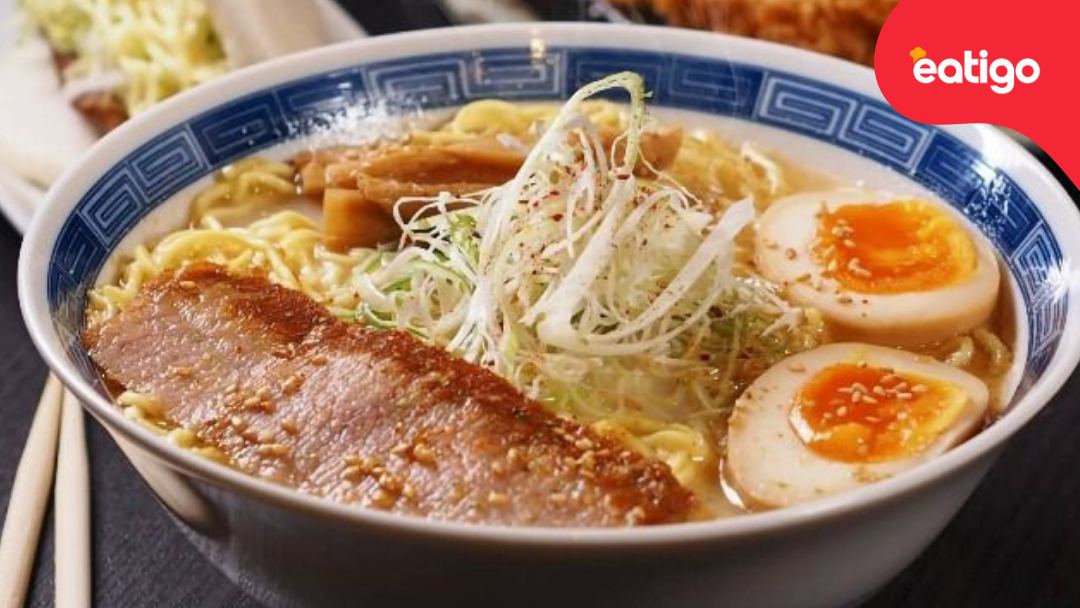Shio vs shoyu ramen – what’s the difference?

30 best dinner restaurants in kl update 2025
September 30, 2024
Tsukemen vs Miso ramen – what’s the difference?
October 3, 2024Welcome to our exploration of two popular styles of ramen: shio and shoyu! While both are beloved staples in Japanese food cuisine, they each offer distinct flavors and characteristics that set them apart. Shio ramen, known for its light and salty broth, contrasts with shoyu ramen, which features a rich soy sauce base.
What’s the difference? Shoyu ramen vs Shio ramen
Shio ramen and shoyu ramen are two popular styles of Japanese ramen, differentiated primarily by the seasoning used in their broths.
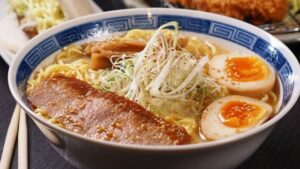
- Seasoning:
- Shio ramen is seasoned with salt (shio), giving it a lighter, more delicate flavor.
- Shoyu ramen is seasoned with soy sauce (shoyu), which imparts a deeper, richer, and slightly salty taste.
- Broth:
- Shio ramen typically has a clear, pale broth made from chicken, fish, or vegetable stock. The salt seasoning allows the broth’s base ingredients to shine, resulting in a clean, refreshing taste.
- Shoyu ramen has a darker, brown broth due to the soy sauce. The broth is often a mix of chicken or pork stock, creating a savory and more robust flavor.
- Flavor:
- Shio ramen is more subtle and mild, appealing to those who prefer a lighter, less overpowering taste.
- Shoyu ramen offers a more complex and bold flavor due to the soy sauce, with more pronounced umami notes.
- Appearance:
- Shio ramen usually appears lighter and clearer, often with pale-colored broth.
- Shoyu ramen has a darker, amber-colored broth due to the soy sauce.
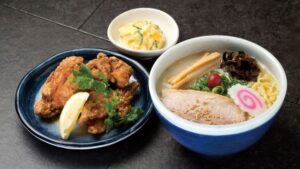
Both types of ramen are delicious but cater to different preferences—shio ramen for those who like a clean and light broth, and shoyu ramen for those who prefer a deeper, more savory flavor.
What is shoyu ramen?
Shoyu ramen is a popular style of Japanese ramen characterized by its soy sauce-based broth. The word “shoyu” means soy sauce in Japanese, and it gives the soup its rich, savory, and slightly salty flavor. The broth is typically made from a mixture of chicken, pork, or vegetable stock, combined with soy sauce for a deep umami taste.
Shoyu ramen is usually served with wavy noodles and is often topped with ingredients like chashu (braised pork belly), menma (bamboo shoots), nori (seaweed), boiled egg, and scallions. The soy sauce base gives the broth a dark, clear color and a lighter, yet flavorful, taste compared to heavier ramens like tonkotsu (pork bone broth).
This type of ramen is one of the most traditional and commonly found across Japan, offering a balanced, comforting flavor that appeals to a wide range of palates.
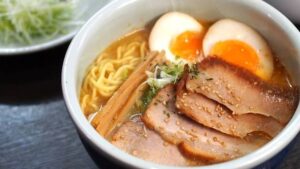
Where to try shoyu ramen in KL
1.Ippudo – A popular chain known for its rich and flavorful ramen, including a delicious shoyu option.
2.Ramen Bar Shishido – This cozy restaurant offers a well-balanced shoyu ramen that is highly recommended by locals.
3.Rakuzen – Known for a range of Japanese dishes, Rakuzen serves a comforting shoyu ramen in a welcoming atmosphere.
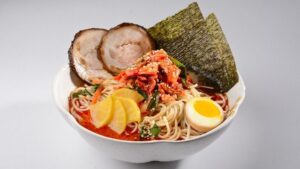
What is shio ramen?
Shio ramen is a type of Japanese ramen that features a clear, light broth seasoned primarily with salt (shio). The word “shio” means “salt” in Japanese, and this seasoning gives the ramen its subtle, delicate flavor compared to other, richer ramen styles like miso or tonkotsu.
The broth for shio ramen is typically made from a base of chicken, fish, or vegetable stock, resulting in a light and clean taste. Unlike heavier ramens, shio ramen is usually clear or pale in color, making it a refreshing choice.
Shio ramen is often served with thin, straight noodles and topped with ingredients like chashu (pork), nori (seaweed), boiled egg, menma (bamboo shoots), and scallions. Its mild, balanced flavor makes it a popular choice for those who prefer a lighter soup that still carries depth and umami.
Where to try Shio ramen in KL
1.Ramen Bar Shishido – Known for its rich and flavorful shio ramen, this spot offers a cozy atmosphere and a variety of toppings.
2.Sushi Zanmai – While famous for sushi, they also serve a delicious shio ramen that’s popular among patrons.
3.Menya Musashi – A well-regarded ramen shop that offers a selection of ramen styles, including shio, with a focus on quality ingredients.
History of ramen
Ramen has a rich history that reflects a blend of cultural influences. It is believed to have originated in China, with wheat noodles served in broth being popular there for centuries. The dish made its way to Japan in the late 19th or early 20th century, likely through Chinese immigrants. The history of ramen is a fascinating journey that traces its origins from China to becoming an iconic Japanese dish.
1. Chinese Origins
Ramen likely originated from Chinese wheat-based noodles, particularly lamian (hand-pulled noodles), which were introduced to Japan by Chinese immigrants in the late 19th century during the Meiji Era (1868–1912). This was a time when Japan was opening up to foreign cultures, and Chinese food, including noodle soups, gained popularity in port cities like Yokohama and Kobe.
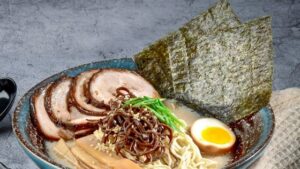
2. Early Japanese Adoption (1900s)
The dish began gaining traction in Japan in the early 20th century. It was initially called “shina soba” (支那そば), meaning “Chinese noodles,” with “shina” being an old term for China. Ramen was served in simple food stalls, especially in bustling urban centers. The original ramen soup was lighter, with a simple soy sauce-based broth.
3. Post-War Boom (1945–1960s)
After World War II, ramen’s popularity surged in Japan. This was due in part to the abundance of cheap wheat flour supplied by the U.S. to Japan during the post-war food shortages. The Japanese government encouraged the production of wheat-based foods, and ramen became an affordable, quick, and filling meal for workers. Mobile ramen stalls became common, and ramen became closely associated with urbanization and modern life.
4. Birth of Instant Ramen (1958)
One of the most pivotal moments in ramen history came in 1958 when Momofuku Ando, the founder of Nissin Foods, invented instant ramen. Ando created Chikin Ramen (chicken ramen), which was the world’s first pre-cooked, packaged instant noodle product. This invention revolutionized the way people consumed ramen, making it easy, affordable, and accessible to people globally.
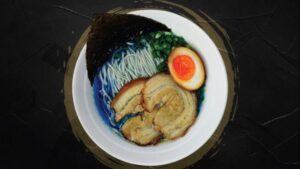
5. Regional Ramen Variations (1970s onwards)
As ramen became more popular, regional varieties started emerging across Japan, each with unique broth styles, toppings, and noodles. Some famous regional ramen styles include:
- Sapporo Ramen (Hokkaido): Miso-based broth, known for its rich, hearty flavor, often served with corn and butter.
- Hakata Ramen (Kyushu): Tonkotsu (pork bone) broth, creamy and rich, served with thin, straight noodles.
- Tokyo Ramen (Kanto): Soy sauce-based broth, light and clear, often accompanied by pork, nori, and bamboo shoots.
- Kitakata Ramen (Fukushima): Shoyu-based broth with thick, curly noodles.
6. Global Ramen Explosion (2000s onwards)
By the late 20th and early 21st centuries, ramen had exploded in popularity both in Japan and globally. Gourmet ramen shops began to appear in major cities worldwide, with chefs experimenting with fusion flavors and high-quality ingredients. Instant ramen also became a global phenomenon, with varieties and brands found in almost every country.

7. Ramen Culture Today
Today, ramen is more than just a dish; it’s a cultural symbol in Japan and beloved worldwide. In Japan, ramen restaurants range from small, local stalls to high-end establishments, and ramen has its own museum (the Shin-Yokohama Ramen Museum) dedicated to its history and cultural significance.
Summary
we’ll delve into the unique attributes of each type, discuss their ingredients, and help you decide which one to try next. Join us as we unravel the delicious differences between shio and shoyu ramen!

